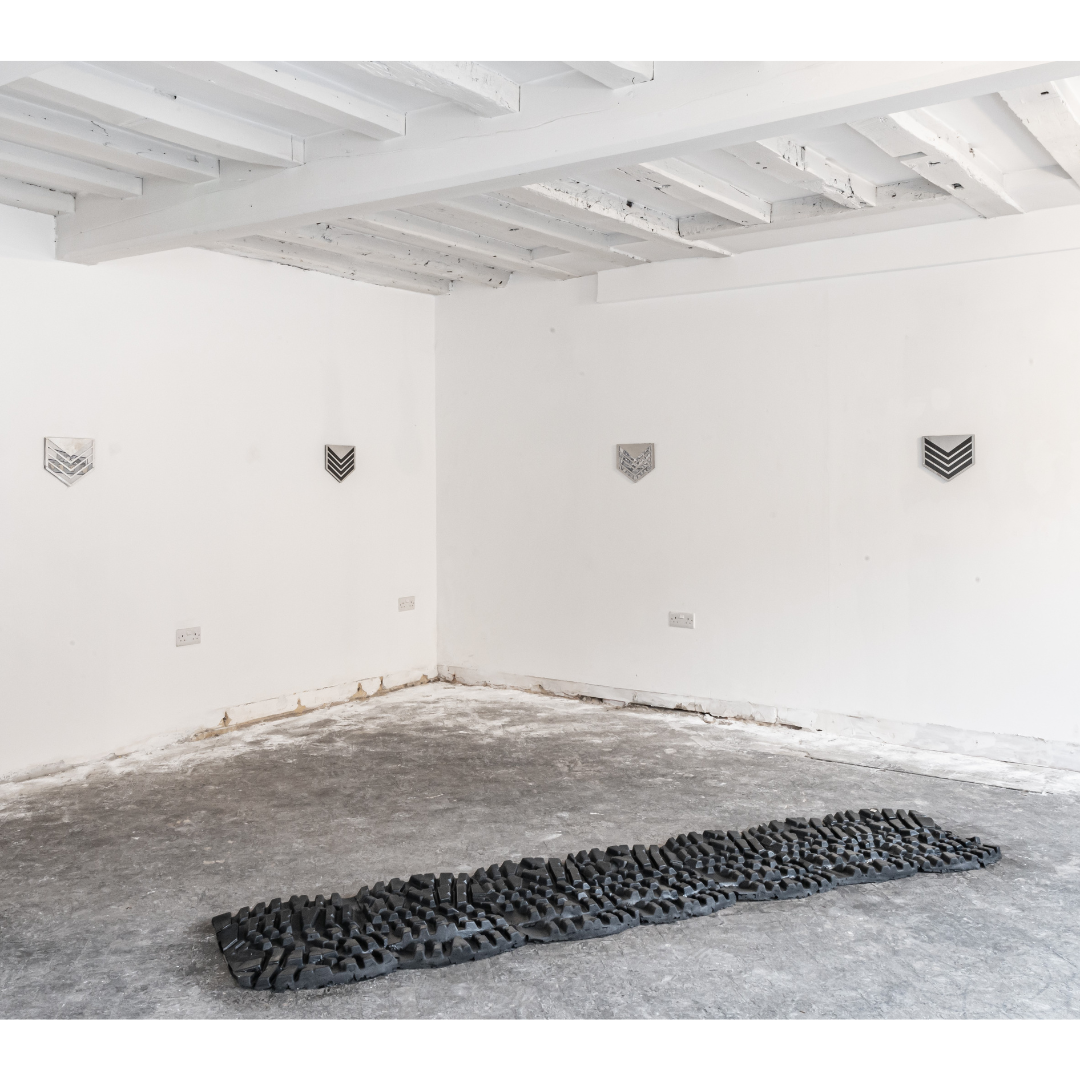






Close Considerations
Juxtaposed material properties: This wall-piece presents a juxtaposition of contrasting material properties. The exterior surface, laser cut from a neutral, standard metal, evokes a sense of danger and coldness through its visual characteristics. Conversely, the interior utilises embossed leather, introducing a tactile softness.
Semiotic interrogation: The work’s interrogative placement at eye-level exaggerates the pomp of the communication of hierarchy and power. By decontextualising the military insignia symbol and altering its scale, Papandreopoulos confronts our instinctive grasp and possible acceptance or rejection of its semiotic associations.
Anachronistic form: Its mythical dimensions place this Untitled work in an imaginative, surreal world engaging viewers beyond its literal banal objecthood, mirroring the imposing scale and ambition of oversized Fascist and Communist statues of idealised masculinity, whereby the strength, virtue and ambition are demonstrated by sheer scale.
Imposing quietude: Despite its large size, the work’s employs a quiet minimalist form, which along with the scale, is imbued with regality and foreboding. This ambiguity in emotional response is intentional, hinting at the multifaceted nature of power and its associated systems.




Process
Phenomenological inquiry and cross-cultural analysis: Theo Papandreopoulos's process draws upon his personal experiences during his service in the Greek military. This experience serves as a foundation for his inquiry into the universal expressions of power. Papandreopoulos utilises military uniforms from various cultures as primary sources to identify potential semiotic markers that consistently convey concepts of power across diverse cultural contexts.
Selection criteria: Papandreopoulos's selection of a specific military rank insignia, along with the chosen materials, is informed by a subjective perceptual impression of the elements, including their perceived force, beauty, and semiotic conceptual potential from his time in the army.
Material exploration & digital fabrication: Following the development of a preliminary visual plan through sketches, Papandreopoulos experimented with material properties of leather and aluminium. The selection of leather for the inner layer of the work was based on the specific material affordances of embossing patterned details. For the exterior, he used computer-aided design (AutoCAD) for rendering the metal component. This software facilitated the laser cutting process, ensuring a high degree of dimensional precision.
Precise execution: The fabrication process for this work was methodical and with minimal deviations from the initial plan, indicating a high level of pre-production planning. This rigorous approach ensured a faithful execution of Papandreopoulos's design.




References
Military Attire: Papandreopoulos's work utilises historical uniform reference books and catalogues as a source for the semiotic analysis of military attire across various cultures. This analysis delves into the symbolic meanings embedded in different uniform elements, enabling an exploration of how cultures use clothing to construct and communicate power.
Authoritarian aesthetic discourse: Papandreopoulos’s monumental, banal objects reference the historical practice of using scale to reinforce power. He has mentioned the colossal pharaoh statues of ancient Egypt, where size directly correlated with a ruler's authority, and more recently, collectivist regimes like Nazi Germany and the Soviet Union employed oversized sculptures of idealised bodies, to overwhelm viewers and instil awe, reinforcing the state's supposed invincibility, right to control as well as to direct citizens’ aspirations.
Tom of Finland’s erotic deviance: Papandreopoulos identifies an aesthetic parallel between the exaggerated masculinity depicted by the collectivist regimes of Nazi Germany and the Soviet Union and Tom of Finland's work which directly deals with their sexual appeal, which the former was fundamentally against. Tom of Finland's work utilises extreme versions of masculinity in uniforms, blurring the line between art and pornography. This reference presents masculinity as a potentially transgressive concept as an individualised erotic deviance in its own right.
Military conscription: A lot of Papandreopoulos’s art practice draws influence from his experience in the Greek military. This experience sharpened his observations of symbols used to establish and reinforce hierarchies and power structures. These symbols can be observed in the imposition of stoic aesthetics, adherence to austerity, enforced uniformity, and emphasis on order. Notably, these elements extend beyond the military context, influencing civilian life through state and corporate control mechanisms.
Samuel Beckett’s examination of disoriented masculinity: The exhibition title originated from Samuel Beckett's short story titled "Echo's Bones," which explores themes of violence and manhood. The regimented life depicted in Papandreopoulos's "Echo's Bones" exhibition, mirroring Beckett's characters in Theatre of the Absurd plays, reflects a potential loss of identity. This suggests a parallel between the disorientation experienced by soldiers in a highly structured environment and the struggles faced by contemporary men grappling with traditional notions of masculinity.
Francis Bacon’s examination of power: By analysing the connections between Samuel Beckett's penultimate work and Francis Bacon's late paintings, a link can be established with Papandreopoulos's practice. All three artists explore the nature of masculinity, portraying it as a constantly shifting concept characterised by doubt and complexity. Their work suggests that male identity is not fixed but rather allows for fluidity and the potential for transformation.



